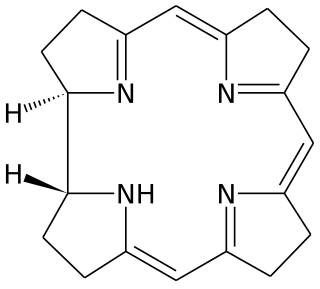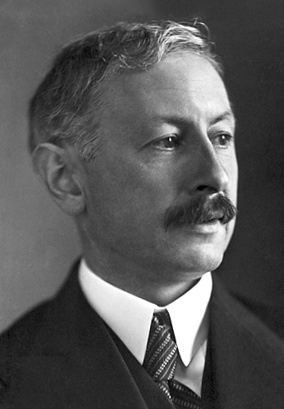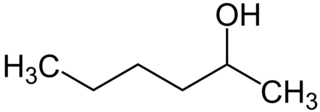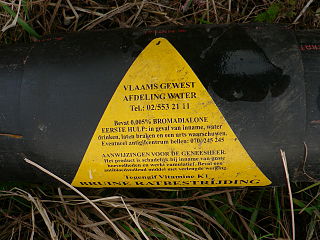Vitamin B8 is a former designation given to several distinct chemical compounds, which are not considered true vitamins:
- Adenosine monophosphate (AMP), or 5'-adylenic acid
- Inositol
Vitamin B8 is a former designation given to several distinct chemical compounds, which are not considered true vitamins:

Vitamin K is a family of structurally similar, fat-soluble vitamers found in foods and marketed as dietary supplements. The human body requires vitamin K for post-synthesis modification of certain proteins that are required for blood coagulation or for controlling binding of calcium in bones and other tissues. The complete synthesis involves final modification of these so-called "Gla proteins" by the enzyme gamma-glutamyl carboxylase that uses vitamin K as a cofactor.

Pantothenic acid (vitamin B5) is a B vitamin and an essential nutrient. All animals need pantothenic acid in order to synthesize coenzyme A (CoA), which is essential for cellular energy production and for the synthesis and degradation of proteins, carbohydrates, and fats.
A nutrient is a substance used by an organism to survive, grow and reproduce. The requirement for dietary nutrient intake applies to animals, plants, fungi and protists. Nutrients can be incorporated into cells for metabolic purposes or excreted by cells to create non-cellular structures such as hair, scales, feathers, or exoskeletons. Some nutrients can be metabolically converted into smaller molecules in the process of releasing energy such as for carbohydrates, lipids, proteins and fermentation products leading to end-products of water and carbon dioxide. All organisms require water. Essential nutrients for animals are the energy sources, some of the amino acids that are combined to create proteins, a subset of fatty acids, vitamins and certain minerals. Plants require more diverse minerals absorbed through roots, plus carbon dioxide and oxygen absorbed through leaves. Fungi live on dead or living organic matter and meet nutrient needs from their host.
VC may refer to:

Corrin is a heterocyclic compound. Although not known to exist on its own, the molecule is of interest as the parent macrocycle related to the cofactor and chromophore in vitamin B12. Its name reflects that it is the "core" of vitamin B12 (cobalamins). Compounds with a corrin core are known as "corrins".
B vitamins are a class of water-soluble vitamins that play important roles in cell metabolism and synthesis of red blood cells. They are a chemically diverse class of compounds.
Vitamin B4 is a former designation given to several distinct chemical compounds, none of which is currently considered a true vitamin:
B6 often refers to:

Paul Karrer was a Swiss organic chemist best known for his research on vitamins. He and Norman Haworth won the Nobel Prize for Chemistry in 1937.

Hexanol may refer to any of the following isomeric organic compounds with the formula C6H13OH:

4-Hydroxycoumarins are a class of vitamin K antagonist (VKA) anticoagulant drug molecules. Chemically, they are derived from coumarin by adding a hydroxy group at the 4 position to obtain 4-hydroxycoumarin, then adding a large aromatic substituent at the 3-position. The large 3-position substituent is required for anticoagulant activity.

Heterocyclic amines, also sometimes referred to as HCAs, are chemical compounds containing at least one heterocyclic ring, which by definition has atoms of at least two different elements, as well as at least one amine (nitrogen-containing) group. Typically it is a nitrogen atom of an amine group that also makes the ring heterocyclic, though compounds exist in which this is not the case. The biological functions of heterocyclic amines vary, including vitamins and carcinogens. Carcinogenic heterocyclic amines are created by high temperature cooking of meat and smoking of plant matter like tobacco. Some well known heterocyclic amines are niacin, nicotine, and the nucleobases that encode genetic information in DNA.
Hexuronic acid is any uronic acid derived from a hexose. These include fructuronic acids, galacturonic acids, glucuronic acids, guluronic acids, iduronic acids, mannuronic acids, and tagaturonic acids.
The molecular formula C6H6N2O may refer to:

Diphenadione is a vitamin K antagonist that has anticoagulant effects and is used as a rodenticide against rats, mice, voles, ground squirrels and other rodents. The chemical compound is an anti-coagulant with active half-life longer than warfarin and other synthetic 1,3-indandione anticoagulants.
Pangamic acid, also called pangamate, is the name given to a chemical compound discovered by Ernst T. Krebs Sr. His son, Ernst T. Krebs Jr., promoted it as a medicinal compound for use in treatment of a wide range of diseases. They also termed this chemical "vitamin B15", though it is not a true vitamin, has no nutritional value, has no known use in the treatment of any disease, and has been called a "quack remedy". Although a number of compounds labelled "pangamic acid" have been studied or sold (including the 1951 d-gluconodimethylamino acetic acid), no chemical compound, including those claimed by the Krebses to be pangamic acid, has been scientifically verified to have the characteristics that defined the original description of the compound.

Organocobalt chemistry is the chemistry of organometallic compounds containing a carbon to cobalt chemical bond. Organocobalt compounds are involved in several organic reactions and the important biomolecule vitamin B12 has a cobalt-carbon bond. Many organocobalt compounds exhibit useful catalytic properties, the preeminent example being dicobalt octacarbonyl.
Castle (gastric) factors, named after the American physician and physiologist W. B. Castle, are biologically active chemical compounds which stimulate haematopoiesis (formation of blood cellular components). There are two distinct factors:
Dishman Carbogen Amcis Ltd is an Indian multinational pharmaceutical company specialized in the manufacture of active ingredients and contract development and manufacturing. Dishman employs over 1,000 people worldwide and is listed on the Bombay Stock Exchange (BSE) and National Stock Exchange of India (NSE).

2-Methylnaphthalene-1,4-diamine is a synthetic menadione analog with vitamin K activity.